
High Plains Gardening
The gardening website of the Texas High Plains Region
“I hold that there is an ascending scale in the enjoyment, and may I not say, the intellectual profit, that
can be got out of a flower. At the lowest point there is the delight of the eye which is provided by the
ready made’ bloom; then there is this and also that added something which comes when we ourselves
have done our little best to forward its development; but there is a higher plane still when, to the delight
and the satisfaction of accomplishment, there is the unknown beyond to lure us on in a quest full of
difficulty and interest. In few flowers is this potentially greater than in the tulip.” (Rev. Joseph Jacobs, Tulips, 1912)
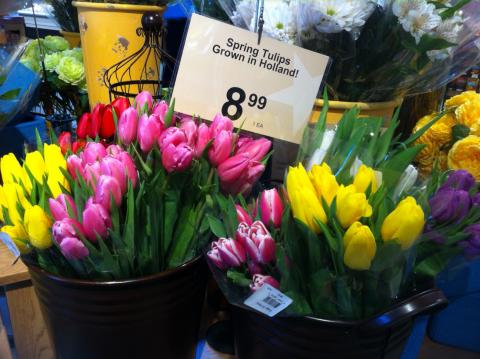 Imagine you are traveling a rugged and rutted two lane road though the steppes of Kazakhstan in the spring. To the south and east are the Tien Shan Mountains, separating the Taklamakan Desert to the southeast and the vast steppes of Kazakhstan to the north. In the south the Tien Shan links up with the Pamir Mountain ranges and extends to the north and east meeting up with the Altai Mountains. As you drive along, gazing out the window, the ground is covered with short tulip-like flowers, first some red, then yellow, and further along a few patches of white, for as long as you can see into the distance. The terrain is similar to the southwestern corner of Wyoming and latitude at approximately 41° - 44° N, but the flora is different. This terrain is the home of the species tulip, a living ancestor of our modern day garden and cut flower favorite.
Imagine you are traveling a rugged and rutted two lane road though the steppes of Kazakhstan in the spring. To the south and east are the Tien Shan Mountains, separating the Taklamakan Desert to the southeast and the vast steppes of Kazakhstan to the north. In the south the Tien Shan links up with the Pamir Mountain ranges and extends to the north and east meeting up with the Altai Mountains. As you drive along, gazing out the window, the ground is covered with short tulip-like flowers, first some red, then yellow, and further along a few patches of white, for as long as you can see into the distance. The terrain is similar to the southwestern corner of Wyoming and latitude at approximately 41° - 44° N, but the flora is different. This terrain is the home of the species tulip, a living ancestor of our modern day garden and cut flower favorite.
When the word tulip is mentioned or thought, our natural association is with Holland, windmills and low-lying marshy land in a cool, overcast and rainy climate. Yet it’s origins are in a climate just the opposite a continent away. There are very few plants that have captured the love, passion and folly of gardeners, and held it, century to century, as tulips have. From the study of the history of the tulip, one follows the history of gardening, floriculture and horticulture science in both the eastern and western world — the tulip, called both the “King of Flowers” (Slater) and the “Queen of Flowers” (Hogg) “a flower that has carried more political, social, economic, religious, intellectual and cultural baggage than any other on earth.” (Pavord, Tulips, p 12.)
What lengths would you go to to grow a flower? How far would your travel to acquire one? How much would you pay, trade or mortgage for one, or for the promise of one? This a a brief story of the long history of the flower we know as the tulip, from man's earliest recorded awareness of it to the cut tulips purchased at the grocers in our vases today.
About the Tulip
Tulips are in the genus Tulipa, in the Liliaceae family. Linnaeus described the genus using Tulipa gesneriana as the genus type in his Species Plantarum in 1753. Today, no one is sure if T. gesneriana still exists in the wild, or even if it was a species tulip or an early cultivar. Jacobs, in his book Tulips, the first book on Tulips in the English language, states, “there seems to be very little doubt that Gesneriana itself is a garden hybrid,” showing that by Linnaeus' day, tulip cultivars were ubiquitous. Tulips are perennial plants classified as geophytes, plants with leaves that die back annually to the underground bulb, corm, tuber or rhizome. Some other common geophytes are crocus, daffodils, potatoes and alliums. There are approximately 5000 different tulips listed in the International Register, published by the Royal General Bulb Growers Association in the Netherlands, with nearly all of them hybrid tulips. There is no exact number of species tulips, known as wild tulips or botanical tulips; it is estimated to be around 75 - 120 species, with new species still being discovered, other relegated to subspecies status as new DNA research is preformed. As with most plant genera where the plant exhibits a wide degree of variation, there is always a bit of confusion whether a new discovery is an existing species, a variation of the species, or a new species.
Tulips are exceptional, certainly, for their individual beauty, regal nature and their ability to charm. Perhaps even more, though, because of their great degree of variability of the species found in the wild and their ability to cross pollinate. Tulips are found natively to be red, red-orange, orange, white, shades of pink to pale violet and yellow, and some with combinations of color. Even members within a species show variability, such as Tulipa greigii as red, yellow and white tepals. It is known as the red tulip, as it was first encountered and described as such. Characteristics of the tulips that vary widely are bulb size and hairiness, stem length, leaf and stem color, number, shape and placement on the stem, the color, size and shape of both inside and outside tepals, color of center blotch (or absence of it), shape of flower both when closed and open, color of the anthers, for a start. The perianth or colored part of the flower we normally think of as petals, for the tulip are called tepals, done so as there is no clear distinction between sepals and petals.
Two Main Centers of Tulip Diversity
 The tulip’s center of diversity and point of origin lies in the valleys, steppes and mountainsides of the Pamir, Hindu Kush and Tien Shan (or Tian Shan) Mountains. This area has for centuries nurtured not only the birthplace of the tulip, but also some species of crocus, colchicums, fritillaria, corydalis, eremurus and many ornamental onion species. Nearly half of the known species of tulips grow wild in this rugged terrain. “The richest variety in the genus Tulipa is found in the middle and lower mountain belts, where also the basic chromosome number is strictly preserved. It appears that there, in the different mountains systems at various altitudes, but no higher than 3000 m, lie the present centers of species formation of the genus Tulipa.” (Botschantzeva, Tulips.) The tulip’s long journey began in Central Asia, in the Karatau Mountains on the northern end of the Western Tien Shan. Within this unique area are found nearly 9% of the worlds endemic plant species (species found no where else). It is an arid region at high altitude and latitude, where salt and fresh water lakes dot the region, a stream or river can be found in every mountain gorge, providing a rare microclimate. Some of the tulips found in this region include Tulipa greigii, T. lemmersii, T. borszczowii, T. kaufmanniana, T. albertii, T. orthopoda and T. buhseana, each growing in preferred microclimates, whether gravelly soil, or on rocky slopes of granite or slates.
The tulip’s center of diversity and point of origin lies in the valleys, steppes and mountainsides of the Pamir, Hindu Kush and Tien Shan (or Tian Shan) Mountains. This area has for centuries nurtured not only the birthplace of the tulip, but also some species of crocus, colchicums, fritillaria, corydalis, eremurus and many ornamental onion species. Nearly half of the known species of tulips grow wild in this rugged terrain. “The richest variety in the genus Tulipa is found in the middle and lower mountain belts, where also the basic chromosome number is strictly preserved. It appears that there, in the different mountains systems at various altitudes, but no higher than 3000 m, lie the present centers of species formation of the genus Tulipa.” (Botschantzeva, Tulips.) The tulip’s long journey began in Central Asia, in the Karatau Mountains on the northern end of the Western Tien Shan. Within this unique area are found nearly 9% of the worlds endemic plant species (species found no where else). It is an arid region at high altitude and latitude, where salt and fresh water lakes dot the region, a stream or river can be found in every mountain gorge, providing a rare microclimate. Some of the tulips found in this region include Tulipa greigii, T. lemmersii, T. borszczowii, T. kaufmanniana, T. albertii, T. orthopoda and T. buhseana, each growing in preferred microclimates, whether gravelly soil, or on rocky slopes of granite or slates.
From this center of Asia, over time, tulips dispersed by seed north to the near steppes of Kazakhstan and into the southern Siberia, south to Kyrgyzstan, Uzbekistan and Turkmenistan, then further on to south and west to Afghanistan, Iraq, and Iran. The eastern edge extends into the Chinese autonomous region of Xinjiang. Onwards they spread to the west across the steppes until they reached Crimea and the Caucasus Mountains, considered to be a secondary center of tulip gene diversity, finally making their way into Turkey, probably over many centuries. How much a role man played in their spread is unknown, as early flower distribution records are scarce. But from the first century BC, the Fergana Valley and the Tien Shan Mountains were transversed on its northern side by the north branch of the Silk Road, a major trade route linking China with western Asia and Europe. One can imagine the groaning of camels and horses snorting as Kazaks and Turks pause at nightly camps, trading goat stomach bags of edible and portable bulbs.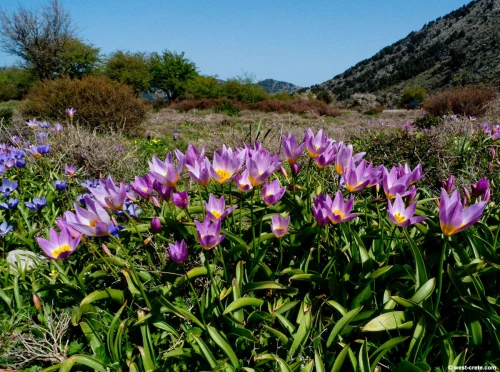
Over time, tulips launched into Europe from Turkey, first along the Balkans, then deeper into Western Europe and eventually down to the Atlas Mountains in northwest Africa. On the eastern and northern front in Middle Asia, tulips spread into the Altai Mountain range into northwestern China and more north into southern Siberia, only stopped by the extreme cold of the arctic. (Photo at right, wild tulips in Crete.)
Middle Asia: Kazakhstan, Uzbekistan, Kyrgyzstan, Tajikistan, Turkmenistan and Russia
More than 63 tulip species, (16 endemic species of tulip) grow in the steppe and meadow zones of the Mountains of Central Asia. The mountain regions are dry, receiving their moisture mainly in the winter and spring. Tulipa greigii, Greig’s tulip, often known as the king of the tulips, is only found in western Tien Shan in the valley of the Syr Dar'yya River, and lands between the Aral and Caspian Sea.
Kazakhstan is a country in Middle Asia of mostly arid and semi arid cold steppes, deserts and high mountain ranges in the southeast part of the country. It is larger in size than the combined square miles of Texas, New Mexico, Arizona, California, Colorado, Wyoming and Montana; larger than Western Europe. It is ninth largest in the world and the largest land-locked country. The terrain ranges from a below sea level sink near the Caspian Sea and rises to peaks over 24,000 feet in the “Celestrial Mountains” of Asia, the Tien Shan. Most of the steppe range from about 900 to 1500 feet above sea level and is the largest dry steppe, or plains, region in the world. Kazakhstan experiences a continental climate with warm summers and cold winters not too unlike the northern Great Plains (except with lower moisture).
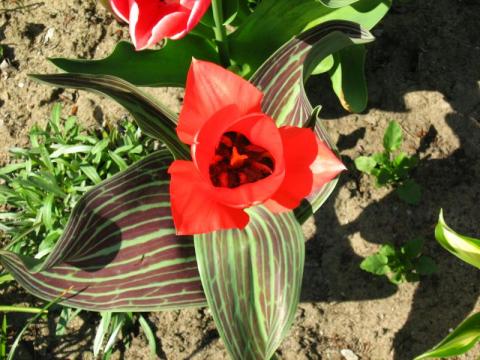 For the past several centuries, Kazakhstan was a closed and isolated country, unspoiled by development or overpopulation. But when independence from the Soviet Union was gained in the 1990's, tourist and scientists have been welcomed in. Having recognized the uniqueness of their country's ecology, many companies now offer eco-tours to view the expanses of wild tulips and endemic species of plants and animals. Fields of springtime blooming tulips is nearly synonymous with Kazakhstan, vying with the image of the Kazakh horseman. So far, 36 varieties of tulip species grow wild in Kazakhstan, with 18 of them listed on the endangered list. (Click here, here and here for ecotours.)
For the past several centuries, Kazakhstan was a closed and isolated country, unspoiled by development or overpopulation. But when independence from the Soviet Union was gained in the 1990's, tourist and scientists have been welcomed in. Having recognized the uniqueness of their country's ecology, many companies now offer eco-tours to view the expanses of wild tulips and endemic species of plants and animals. Fields of springtime blooming tulips is nearly synonymous with Kazakhstan, vying with the image of the Kazakh horseman. So far, 36 varieties of tulip species grow wild in Kazakhstan, with 18 of them listed on the endangered list. (Click here, here and here for ecotours.)
Kyrgyzstan lies south of Kazakhstan and is a good deal more mountainous. About 22 varieties of tulips grow in Kyrgyzstan, eight of them on endangered list. Many of the natural range of the various species overlap. Information about Kyrgyzstan's flora is more scant, however, the growing conditions are similar to the other countries in Middle Asia.
Russian botanists have been studying the wild species tulips since the nineteenth century. One of the first and greatest Russian explorers was Eduard Regel, who was director of the St. Petersburg Botanic Garden from 1855. He described over 3000 new plant species, many from the Russian Far East and Asia. At that time, many of today's countries in Middle Asia were part of Russia. Eduard and his son Albert Regel led many plant exbitions, collecting countless tulips and bulbs, father and son describing at least 22 new species, including T. greigii, T. praestans and T. kaufmanniana some of the most popular species tulips today. Tulipa regelii and T. albertii are named after them. Eduard Regel was the first to split the genus into two, with much of his classification still standing. Regel was generous with his tulip bulbs and shared many with his Western European counterparts, enabling many new tulips and hybrids to come into cultivation. (Tulipa greigii at left.)
Aleksei Ivanovich Vvedensky wrote the account of “Tulipa” for Flora of the USSR (1958), translated in English, 1968, covering species from the Caucaus to Tien Shen and Pamir Alai. (Wilford, Tulips, p. 59.) (Photo at left is T. vvendski 'Tangerine Beauty')
Perfect Climate: Cold Moister Winter/Spring and Dry Summer
One of the most recent and definitive studies on tulips of Central Asia was done by Dr. Zinaida Botschantzeva in 1962, whose book, Tyul,pany or Tulips: Taxonomy, Morphology, Cytology, Phytogeography and Physiology was translated into English in 1982. In it, Professor Botschantzeva makes a distinction between the terms Central Asia and Middle Asia. In Russian literature, she notes, the term Middle Asia is used to refer to the area of the Irano-Turanian steppes, semideserts and deserts east of the Caspian Sea, extending north of the Himalyas to the Altai and Pamir Mountains, while Central Asia comprises Sinkiang, Tibet and Mongolia. She explains the main difference is in the amount of rainfall, with Middle Asia receiving rain mainly in winter and early spring, which favors the occurrence of geophytes, whereas in Central Asia, winter and spring are extremely dry with rain falling in the summer. This is an important note in understanding the natural climate of the tulip. This was the only reference I read that made this distinction however, with all references agreeing on the original natural range of species tulips as Central Asia. Professor Botschantzeva worked for nearly 50 years at the Taskent Botanical Gardens and traveled thousands of miles through the steppes, semi-desserts and mountains of Middle Asia, and received her doctorate in 1960 on the study of tulips. (Wilford, Tulips and Botschantzeva, Tulips p. 4)
Taskent received an average of 7 inches of rain from October to December with 30 precipitation days; and 15 inches of precipation over 52 days, January through April. Istanbul's climate is somewhat similar, receiving 10 inches of rainfall October to December with 32 precipitation days; and received nearly 11 inches of precipation January through April with 57 precipitation days. The climate from Turkey to Middle Asia receives rainfall frequently enough and in sufficient quantities for tulip seeds to germinate and bulbs to grow, mature and flower year to year. (Wilford, "Tulip Species in Cultivation", Slide 12, Presentation.) Wilford noted in his book, Tulips, Species and Hybrids for the Gardener, that tulips seedlings must not dry out, but needs steady moisture. Seeds lie dormant through the hot dry summer and germinate once the weather cools in September and the rains return. This is the natural climate of the tulip.
Professor Bortschantzeva spent her career mapping and studying tulips, discovering and describing several new species, including Tulipa affinis, T. vvedenskyi and T. uzbekistanica. She built up the tulip collection at the Taskent Botanical Garden of the Academy Sciences to be the largest Middle Asian tulip collection in the world, containing about 6000 geophyte specimens and more than 2000 wild and garden tulips. Unfortunately, upon her death in 1973, the geophyte collection languished due to neglect. However, efforts are recently being made to restore the collection and preserve Uzbekistan and Middle Asia's tulip heritage. Middle Asian and Turk authorities are moving to conserve tulips in the wild, whose numbers are dwindling with many species endangered, while only a few are on the endangered list. Uzbekistan is home to 30 known tulip species. Key challenges faced in both centers of diversity are harvesting of tulips and bulbs in the wild by local populations, urbanization, road works, cultivation of land, and grazing by livestock. (Komil, “Tulips in Uzbekistan”, presentation.)
The most northern extent of the tulips' natural range is the Atlai Mountains, into northwestern China, Mongolia and southern Sibera where T. altaica, T. kolpakowskiana, T. uniflora, T. heteropetala and T. patens live. This is a brutal climate with long freezing winters and hot summers reaching an occasional 100° day, therefore, these varieties need to be grown more as one would alpine plants. Winters are dry, as all water is frozen solid. (Wilford, Tulips.)
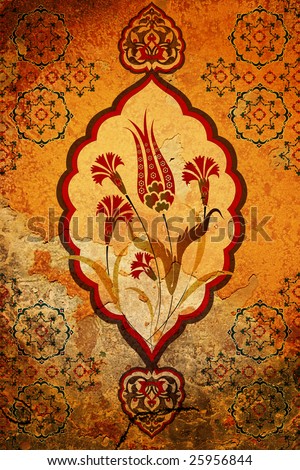 Over a thousand years ago, tulips were loved and admired, used as motifs and ornamentation. One of the earliest mentions to tulips refers to the eleventh century in the “Book of Tulip Gardens in Istanbul”, mentioning “that before the Seljuk invasion of Baghdad in 1055, only one kind of tulip, the Sahra-i Laie, or meadow tulip, was known in Istanbul.” “Tiles decorated with tulips, made by the Anatolian Seljuks, have been excavated” dating back to 1096. (Pavord, Tulips, p. 30.)
Over a thousand years ago, tulips were loved and admired, used as motifs and ornamentation. One of the earliest mentions to tulips refers to the eleventh century in the “Book of Tulip Gardens in Istanbul”, mentioning “that before the Seljuk invasion of Baghdad in 1055, only one kind of tulip, the Sahra-i Laie, or meadow tulip, was known in Istanbul.” “Tiles decorated with tulips, made by the Anatolian Seljuks, have been excavated” dating back to 1096. (Pavord, Tulips, p. 30.)
A Persain poet of great repute from Bengal to Constantinople from the thirteenth century to the present day, Musharrifu'd-din Sa'di, described a garden in his poem 'Gulistan' in 1258: “The murmur of a cool stream bird song, ripe fruit in plenty, bright multicolored tulips and fragrant roses. . .”
Ali-Shir Nawa writes in the fifteen century in his poem “Farhad u Shirin': “wine in green bowls I can compare only to scarlet tulips in a meadow.” And in another poem, Leili u Majnun': “when the tulip came to know a sorrow a black mark appeared on its heart.” Ali-Shir Nawa lived in Samarkand in his younger days and was probably referring to T. fosteriana or T. micheliana with the pointed black blotches. (Botschantzeva, p.1)
Samarkand is one of the oldest inhabited cities in the world, on a southern branch of the Silk Road in Uzbekistan just west of Taskent. Samarkand was known as Maracanda by the Greeks at the time of Alexander the Great, when he conquered it in 329 BC., which was later captured by the Turks nearly a thousand years later in 710 AD. No doubts tulips, a highly portable plant in bulb form, thrived in the area for centuries and would have been noticed and traded up and down the Silk Road.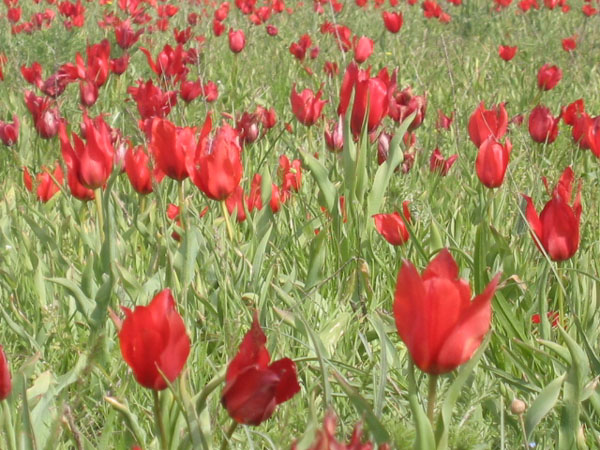
Horses were domesticated early in Middle Asia, with many of the native peoples described as nomadic tribes that moved across the land. As the tulip bulb is edible, perhaps tulips were dug up, used for food, or traded as the peoples migrated. This is just speculation on my part, as I have found no references of the nomads eating the bulbs (however, there are a few references indicating they were eaten by Europeans, mistaking them for onions).
The Emperor Babur of the Mughal Empire, also known as the warrior gardener, constructed gardens wherever he went, recorded his description of the Fergana Valley (now in Uzbekistan) by the Andijan River in Babur Nama in 1495: “in the spring they are most beauti ful with the blossoming of many tulips and roses,” and “Tulips of many colours cover these foothills: I myself counted 32 or 33 different sorts.” (Babur Nama.) T. ferganica is named after this fertile valley, where it grows along the stony slopes. T. ferganica is a golden tulips tinged with a violet or reddish-purple blush, gorwing to 6-10 inches tall. Perhaps T. ferganica are now longer to be found in the valley, as it is a rich agricultural region.
ful with the blossoming of many tulips and roses,” and “Tulips of many colours cover these foothills: I myself counted 32 or 33 different sorts.” (Babur Nama.) T. ferganica is named after this fertile valley, where it grows along the stony slopes. T. ferganica is a golden tulips tinged with a violet or reddish-purple blush, gorwing to 6-10 inches tall. Perhaps T. ferganica are now longer to be found in the valley, as it is a rich agricultural region.
Constantinople was the seat of the Roman, Latin and Byzantine Empire. Situated at the juncture of the West and the Ottoman Empire, regulating trade between Europe and Asia, if Europeans (other than the European Russians) or the Holy Roman Empire were aware of tulips, they did not use them in ornamentation. There are no known references to tulips in gardens or other records. After trying to conquer Constantinople for over seven hundred years, gateway to the Mediterranean and Europe, the Ottomans under Mehmed II finally broke through the defenses and conquered the city, which became know as Istanbul thereafter.
Tulips seem to have the ability to bewitch people, to drive men wild with desire. Sultan Mehmed (Mehmet) II 1451-1481), a fearsome warrior and ruler, conqueror of Constantinople, fell to the spell of the tulip, filling his 12 gardens with tulips, as well as colchicums, violets, roses, narcissus, saffron crocus, and Persian lilac. Mehmed II built the palace Topkapi, designed to outdo the magnificence of any other palace on earth (to his knowledge). “Mehmed, a passionate gardener who collected rare plants from every part of his domain” which now reached from Hungary, Greece, Turkey and ever eastwards. (Dash, p 18) The Turkish gardens were different from regimented European gardens. Turks created gardens as a place of lushness and escape, gardens that resembled a paradise combining flowers with fruit and nut trees, often with streams running through them. (Dash, p 17.) Tulips played an ever increasing part in their gardens.
And the Europeans noticed the gardens, as many European ambassadors flocked to Istanbul, now as it was called, after the defeat of Constantinople. Although the Europeans considered the Turks savages because of their brutality, there were astounded by their culture, art and manners.
Here we have a lapse of about a hundred years from the final siege of Constantinople until tulips finally made their way into Europe in a noticeable way. Even though ambassadors were dispatched in hopes of placating the Turks and staying the Ottoman tide, entreaties most likely weren't immediately made. Mehmed II was known for his savagery, having sacked the city and killing many. He was a hard and unforgiving ruler to those who opposed or failed him. It took time for the new Istanbul to be built into a Turkish city filled with tulips. Mehmed II servants scoured Turkish territories for tulips and other plants for his garden. The conquest of Constantinople, and subsequent events was instrumental two hundred years later in the Dutch craze called tulipomania.
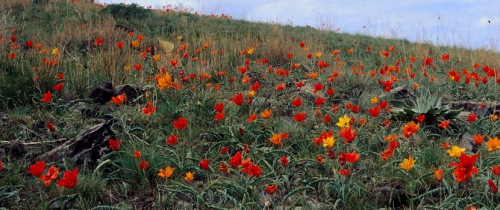 Tulips were revered as holy by the Muslims. The Turkish word for tulip, “lale”, is derived from the Persian and was written with the same Arabic letters as were used for the name of Allah. But it wasn't used as a religious symbol or for other ornamental motifs in Ottoman culture until after the Islamic prohibition against portraying living things was relaxed. This might explain its early absence on buildings and other artifacts.
Tulips were revered as holy by the Muslims. The Turkish word for tulip, “lale”, is derived from the Persian and was written with the same Arabic letters as were used for the name of Allah. But it wasn't used as a religious symbol or for other ornamental motifs in Ottoman culture until after the Islamic prohibition against portraying living things was relaxed. This might explain its early absence on buildings and other artifacts.
Europe Learns of the Tulip
The first mention of tulips to western Europeans was a result of an ambassador to the Austrian court, an influential Netherlander, Ogier Ghislain de Busbecq. Countries closest to Turkey, as one would naturally assume, imported the easily transported onion-like bulb. First to the gardens in Bavaria, Vienna and Salzburg, then on the France during the reign on Louis XIV.
The tulip’s journey out of Asia Minor and into Europe is believed to have began by Busbecq, Ferdinand I’s ambassador from the Hapsburgs to the court of Suleiman the Magnificent (reigned 1520 – 1566) in Constantinople. Busbecq was known to have sent plants back to Vienna and Prague. Busbecq traveled to Istanbul and remained in the Ottoman Empire for nearly eight years. It is believed he either carried tulip bulbs back with him during occasional visits home, or sent back bulbs, which were new to him and greatly admired. On November 3, 1554, he wrote “we are going on towards Constantinople, now near, for we were almost accomplishing the end of our journey, and as we were passing through the district an abundance of flowers was everywhere offered to us — Narcissus, Hyacinths, and those which the Turks call tulipam, much to our wonderment, because of the time of year, it being almost the middle of winter, so unfriendly to flowers. . . Scent in tulips is wanting or very slight; they are admired for the variety and beauty of colors. The Turks cultivate flowers with extreme zeal, and though they are careful people, do not hesitate to pay a considerable sum for an exceptional flower.” (Pavord, Tulips, Dash, and others)
However, new research indicates Busbecq wrote these letters twenty years after returning to Europe, between 1581— 1589. Busbecq's memory was either clouded or he was remembering a later journey to Istanbul, as tulips do not flower in the middle of winter. (Illustration from Ein Garten Eden (2001) by H. Walter Lack and translated by Martin Walters illustrating Busbecq's tulips.)
First European written knowledge of tulips may well be credited to a Frenchman, Pierre Belon where he described his adventures traveling to Turkey, calling tulips ‘Lils rouges’ (red lilies) in Les Observations de Plusieurs Singularites, published in 1553. (Busbecq was Flemish, then part of what became known as the United Provinces of the Netherlands, however the region of Busbecq's birth is now in France.) More on the tulip's path in Europe later.
As is now known, the Turks did not call tulips Tulipam, but lale. Due to a misunderstanding in communications, when Ambassador Busbecq asked what flower was worn in the Turk’s turban, his interpreter, thinking he meant the folded turban, responded “dulbend” (in Persian), which sounded like tulband, which became tulipam, and eventually tulip. Some references point out that “dulbend” or “tulband” means linen gauze. The Turks continue to refer to tulips by their original name, lale.
Sultan Selim II, from the sixteenth century, was said to be besotted with tulips. “In 1574, he ordered the Sheriff of Aziz (now Azez in Syria) . . . to send him 50,000 tulip bulbs for the imperial gardens at Constantinople. . . Another 300,000 bulbs were dispatched for the palace gardens from Kefe” (now Feodosiya in Crimea, formerly the Ukraine, just recently annexed to Russia) a port city across from Turkey on the Black Sea. One of the tulips gathered in the wild most assuredly have been T. schrenkii, from the steppe region of the Crimea. (Pavord, Tulips, p. 35)
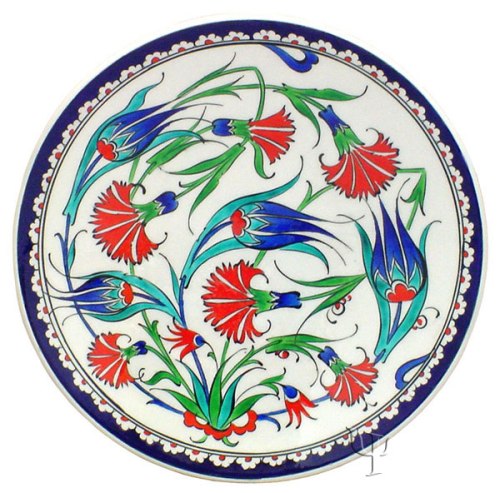 By the middle of the sixteenth century, the symbol of the tulip was being used by more people than just the sultans, being embroidered on to prayer rugs, saddles, pottery, and clothes. Under Suleiman, it is believed the Turks first began to cultivate the tulip and breed new varieties. (Dash, p. 19) This was the first appearance of tulips with long pointed tepals (petals) resembling daggers, rather than the native wild egg or bowl shaped tulips. Tulipa acuminata is an example of this type of this look. T. acuminata is not considered to be a botanic tulip, but a hybrid of unknown origin (photo at right).
By the middle of the sixteenth century, the symbol of the tulip was being used by more people than just the sultans, being embroidered on to prayer rugs, saddles, pottery, and clothes. Under Suleiman, it is believed the Turks first began to cultivate the tulip and breed new varieties. (Dash, p. 19) This was the first appearance of tulips with long pointed tepals (petals) resembling daggers, rather than the native wild egg or bowl shaped tulips. Tulipa acuminata is an example of this type of this look. T. acuminata is not considered to be a botanic tulip, but a hybrid of unknown origin (photo at right).
By 1630, Istanbul flourished as a hotbed for tulip fanciers. Early tulips were collected from the wild, rather than bred for specific traits, as was soon to happen. Istanbul was estimated to have over 300 florists and eighty flower shops. A traveler, Evliya Celebi, chronicled how richly the surrounding gardens were filled with tulips, as were the meadows nearby. Clusius (Charles de l’Ecluse, the first director of the botanic garden at Leiden in Holland), indicated the Sultan Murad IV (1609-1640) possessed 56 kinds of tulips, only having one bulb of some species. (Pavord, Tulips).
By the 1700, the craze for tulips in the Ottoman Empire escalated. “The Grand Vizier.. .and others of the Court have a great taste for flowers, above all for Tulips. . . . There are 500,000 bulbs in the Grand Vizier’s garden. When the Tulips are in flower and the Grand Vizier wants to show them off to the Grand Seigneur {a feudal lord}they take care to fill in any spaces with Tulips picked from other gardens and pit in bottles,” The French ambassador, Monsieur d’Andresel, to Constantinople wrote in 1726. Nightly elaborate and extravagant tulip parties were held during the length of the tulip season at the court. (Pavord, Tulips, p. 46.)
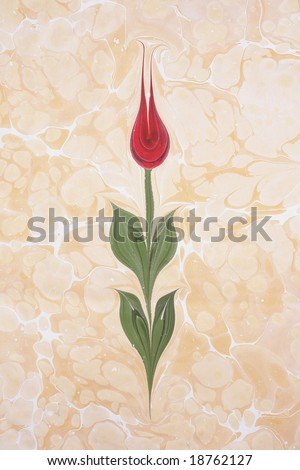 About the same time, The Book of Tulips was published, listing and illustrating the more expensive tulips available in Turkey. This was already 65 years after the Dutch Tulipomanea. To
About the same time, The Book of Tulips was published, listing and illustrating the more expensive tulips available in Turkey. This was already 65 years after the Dutch Tulipomanea. To 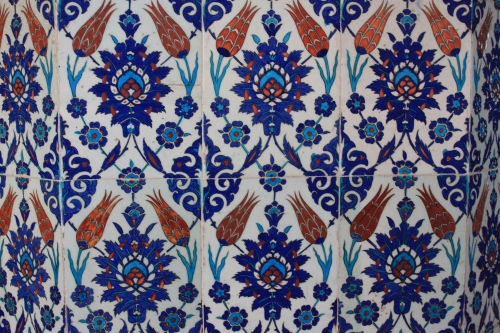 keep the Turkish tulip mania under check, the government issued official price lists for tulips. A later “manuscript, Lalezar-i Ibrahim (Notes of Ibrahim, a Tulip Grower), lists 850 varieties.” A different “Notes of a Tulip grower in Istanbul listed names and characteristics of 1108 tulips grown in Istanbul between 1681 and 1726.” A further list includes 1323 varieties. By the early eighteenth century, the Turks were well on its way in breeding tulips, just as the European florists have been. (Pavord, Tulips, p. 50.)
keep the Turkish tulip mania under check, the government issued official price lists for tulips. A later “manuscript, Lalezar-i Ibrahim (Notes of Ibrahim, a Tulip Grower), lists 850 varieties.” A different “Notes of a Tulip grower in Istanbul listed names and characteristics of 1108 tulips grown in Istanbul between 1681 and 1726.” A further list includes 1323 varieties. By the early eighteenth century, the Turks were well on its way in breeding tulips, just as the European florists have been. (Pavord, Tulips, p. 50.)
Long prized by the Ottoman Empire, European visitors to the courts took note of the esteemed Lale. The reign of Sultan Ahmed III (1703-1730) was referred to as the Lale Devri, the “Tulip Era”. Even though tulips was admired and feted throughout the Ottoman and Arabic lands for centuries, Sultan Ahmed III ordered millions of tulip bulbs to decorate his gardens from Holland, already a thriving center of tulip production. In the past, the tulip was often celebrated singly in a narrow necked vase (laledan) for maximum specimen appreciation, never in bouquets or mixed with other flowers. By the eighteenth century, Western styles influenced the Sultan’s court, with European style tulips and displays in bunches with other flowers. (Pavord, Tulips, p. 44-45.)
The life story of Ahmed III is a sad story of the custom of Turkish succession to the throne, a story of debauchery and excess, and eventually decline in an empire. After the reign of Ahmed III, the tulips prominence waned from the pinnacle it had been placed, although it was still used in motifs. Today, the tulips retains its prominence as the national flower of Turkey. In 2006, during the Istanbul Tulip Festival, the tulip was reintroduced to the city in a big way, planting 3 1/2 million tulips, increasing each year to 20 million tulips for Istanbul's 8th (Lale) Tulip Festiva.
Three hundred years before the English breeders and florists developed stringent requirements, the Turk florists judged new cultivars in the Ottoman Empire according to exacting standards. Early on in man’s appreciation of tulips, it was the lily-like, and dagger shaped tulips with needle-pointed petals that was most esteemed and commemorated, celebrated in Ottoman art as well as gardens.
In all, it is believed there are about 75 - 120 different species in the wild throughout the world, most of them displaying great diversity within their species. Seventeen species and one subspecies (3 new species found since 1999) grow in the wild in Turkey, although only four are considered native, T. armena, T. biflora, T. humulis and T. julia. (Pavord, Tulips p. 28, 29 and Ozhatay; current findings on native and endemic species tend to change as well.)
References listed at the end of Part 4.
For Part 2, Europe, the Dutch and Tulipomania, click here.
Angie Hanna, April 8, 2014